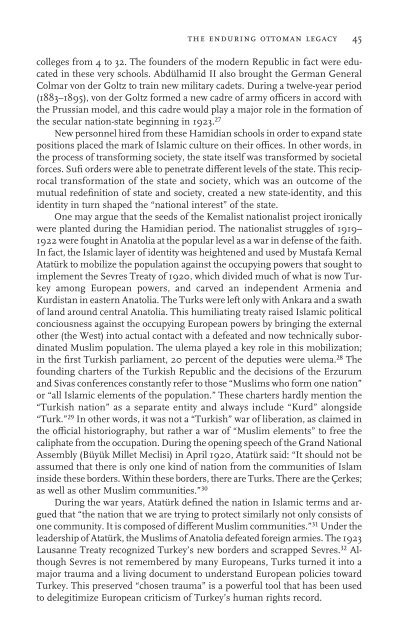You also want an ePaper? Increase the reach of your titles
YUMPU automatically turns print PDFs into web optimized ePapers that Google loves.
the endur<strong>in</strong>g ottoman legacy 45colleges from 4 to 32. The founders of the modern Republic <strong>in</strong> fact were educated<strong>in</strong> these very schools. Abdülhamid II also brought the German GeneralColmar von der Goltz to tra<strong>in</strong> new military cadets. Dur<strong>in</strong>g a twelve-year period(1883–1895), von der Goltz formed a new cadre of army oYcers <strong>in</strong> accord withthe Prussian model, and this cadre would play a major role <strong>in</strong> the formation ofthe secular nation-state beg<strong>in</strong>n<strong>in</strong>g <strong>in</strong> 1923. 27New personnel hired from these Hamidian schools <strong>in</strong> order to expand statepositions placed the mark of <strong>Islamic</strong> culture on their oYces. In other words, <strong>in</strong>the process of transform<strong>in</strong>g society, the state itself was transformed by societalforces. SuW orders were able to penetrate diVerent levels of the state. This reciprocaltransformation of the state and society, which was an outcome of themutual redeWnition of state and society, created a new state-identity, and thisidentity <strong>in</strong> turn shaped the “national <strong>in</strong>terest” of the state.One may argue that the seeds of the Kemalist nationalist project ironicallywere planted dur<strong>in</strong>g the Hamidian period. The nationalist struggles of 1919–1922 were fought <strong>in</strong> Anatolia at the popular level as a war <strong>in</strong> defense of the faith.In fact, the <strong>Islamic</strong> layer of identity was heightened and used by Mustafa KemalAtatürk to mobilize the population aga<strong>in</strong>st the occupy<strong>in</strong>g powers that sought toimplement the Sevres Treaty of 1920, which divided much of what is now <strong>Turkey</strong>among European powers, and carved an <strong>in</strong>dependent Armenia andKurdistan <strong>in</strong> eastern Anatolia. The Turks were left only with Ankara and a swathof land around central Anatolia. This humiliat<strong>in</strong>g treaty raised <strong>Islamic</strong> politicalconciousness aga<strong>in</strong>st the occupy<strong>in</strong>g European powers by br<strong>in</strong>g<strong>in</strong>g the externalother (the West) <strong>in</strong>to actual contact with a defeated and now technically subord<strong>in</strong>atedMuslim population. The ulema played a key role <strong>in</strong> this mobilization;<strong>in</strong> the Wrst Turkish parliament, 20 percent of the deputies were ulema. 28 Thefound<strong>in</strong>g charters of the Turkish Republic and the decisions of the Erzurumand Sivas conferences constantly refer to those “Muslims who form one nation”or “all <strong>Islamic</strong> elements of the population.” These charters hardly mention the“Turkish nation” as a separate entity and always <strong>in</strong>clude “Kurd” alongside“Turk.” 29 In other words, it was not a “Turkish” war of liberation, as claimed <strong>in</strong>the oYcial historiography, but rather a war of “Muslim elements” to free thecaliphate from the occupation. Dur<strong>in</strong>g the open<strong>in</strong>g speech of the Grand NationalAssembly (Büyük Millet Meclisi) <strong>in</strong> April 1920, Atatürk said: “It should not beassumed that there is only one k<strong>in</strong>d of nation from the communities of Islam<strong>in</strong>side these borders. With<strong>in</strong> these borders, there are Turks. There are the Çerkes;as well as other Muslim communities.” 30Dur<strong>in</strong>g the war years, Atatürk deWned the nation <strong>in</strong> <strong>Islamic</strong> terms and arguedthat “the nation that we are try<strong>in</strong>g to protect similarly not only consists ofone community. It is composed of diVerent Muslim communities.” 31 Under theleadership of Atatürk, the Muslims of Anatolia defeated foreign armies. The 1923Lausanne Treaty recognized <strong>Turkey</strong>’s new borders and scrapped Sevres. 32 AlthoughSevres is not remembered by many Europeans, Turks turned it <strong>in</strong>to amajor trauma and a liv<strong>in</strong>g document to understand European policies toward<strong>Turkey</strong>. This preserved “chosen trauma” is a powerful tool that has been usedto delegitimize European criticism of <strong>Turkey</strong>’s human rights record.




